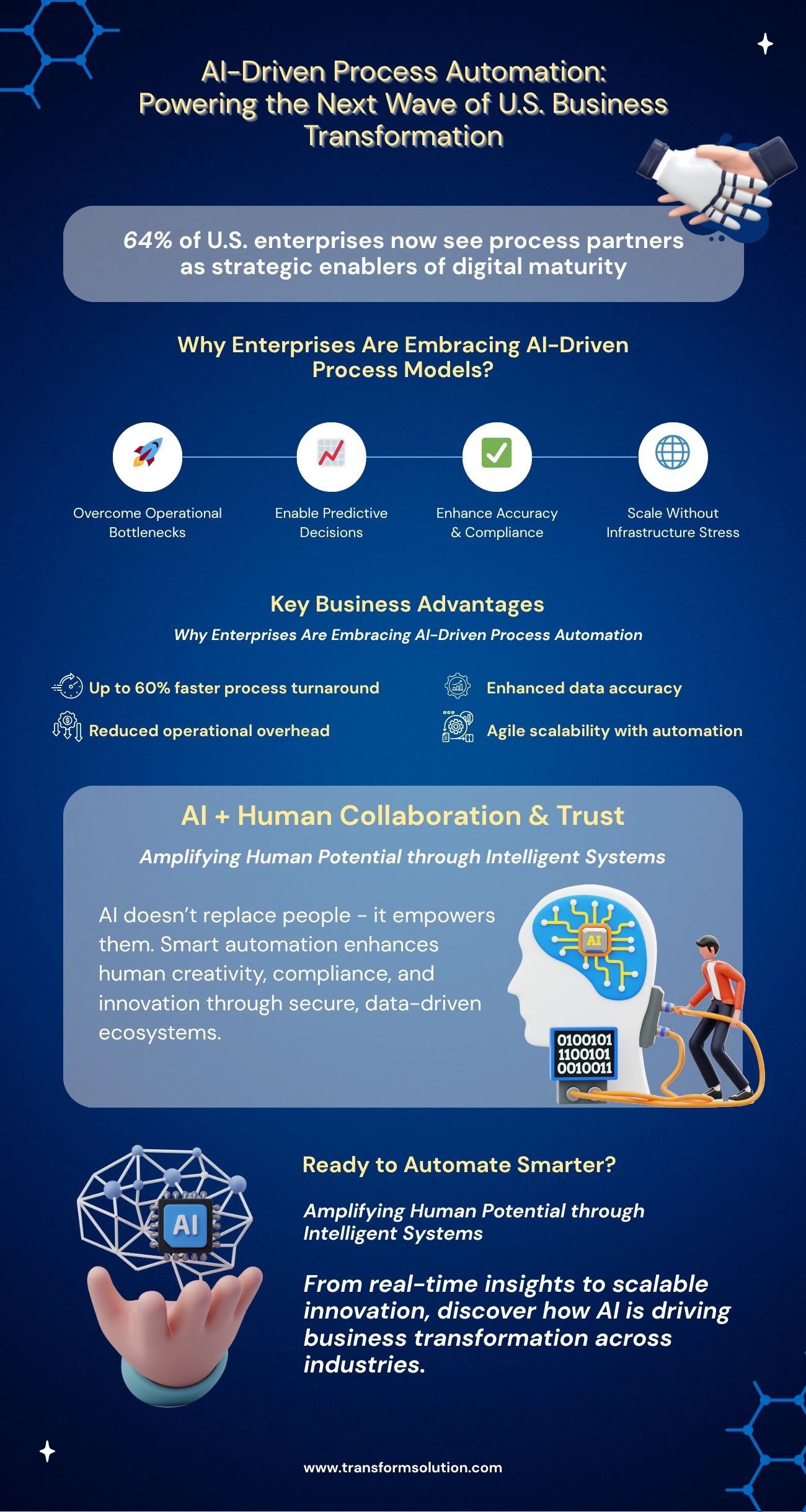
In the fast-moving world of American enterprise, every organization—whether a fintech startup in New York, a manufacturing firm in Texas, or an eCommerce powerhouse in California—is feeling the same pressure: automate or fall behind.
The digital revolution has redefined how companies operate. Yet, many still struggle to balance innovation with efficiency. That’s where AI-driven outsourcing and process automation are transforming the game.
Instead of traditional outsourcing, where cost reduction was the goal, U.S. businesses are now investing in strategic partnerships that merge human expertise with automation, artificial intelligence, and analytics.
These partnerships empower companies to focus on innovation while specialized partners handle the complexity of data management, back-office operations, and business process optimization.

For decades, outsourcing meant delegating repetitive work offshore to save costs. But in 2025, the U.S. market demands more than labor arbitrage—it demands capability expansion.
AI-driven outsourcing delivers speed, accuracy, and scalability that manual processes simply can’t match. According to Gartner’s 2024Enterprise Agility Report, more than 64% of U.S. enterprises now view outsourcing partners as strategic enablers of digital maturity rather than cost-saving vendors.
What Changed?
This evolution has created a new class of transformation partners—firms that bring together AI, process automation, and analytics to create agile, high-performing systems.
a. To Overcome Operational Bottlenecks
In traditional business setups, employees spend hours on manual reporting, order processing, or customer support. AI automation eliminates these repetitive tasks, freeing teams to focus on growth and strategy.
b. To Enable Predictive Business Decisions
Modern enterprises use machine learning to anticipate customer behavior, market shifts, and operational inefficiencies. Predictive analytics transforms data into foresight, allowing companies to act before problems escalate.
c. To Enhance Accuracy and Compliance
AI systems can track transactions, verify data, and detect anomalies at scale. This reduces human error, strengthens audit trails, and ensures compliance with U.S. and global regulations.
d. To Scale Without Infrastructure Stress
AI-driven outsourcing gives enterprises on-demand access to tools, data, and expertise—without building large internal teams. It’s efficiency without expansion.
AI-driven process automation integrates machine learning, robotic process automation (RPA), and analytics into everyday workflows. Here’s how it reshapes business performance:
1. Speed and Efficiency
Automation reduces process turnaround times by up to 60%,increasing throughput without extra resources.
2. Cost Optimization
Smart automation minimizes operational costs and reallocates budgets toward innovation.
3. Data Accuracy
AI-powered systems capture and validate data in real time, maintaining clean, actionable information across platforms.
4. Scalability
Automated processes adjust dynamically to meet changing market demands—no extra staffing required.
5. Innovation Enablement
When human teams aren’t bogged down by repetitive tasks, creativity thrives. AI makes room for innovation.
Artificial Intelligence is no longer futuristic—it’s foundational. For U.S. businesses, integrating AI with outsourcing frameworks isn’t optional; it’s essential to stay competitive.
How AI Integration Works
Example:
A U.S.-based eCommerce firm uses AI automation to update thousands of product listings, track orders, and generate inventory forecasts daily. What once required multiple employees now happens automatically—24/7—with zero errors.
AI doesn’t replace people; it amplifies human performance.
Trust and data governance sit at the heart of every successful outsourcing relationship. In the age of AI, security and compliance are no longer afterthoughts—they’re competitive advantages.
Key Trust Pillars
When businesses know their partners safeguard sensitive data and operate ethically, they can innovate confidently.
Remote work is no longer an experiment—it’s a proven model of success. AI-driven collaboration tools now enable teams across the globe to work seamlessly and efficiently.
Advantages of Global Team Integration
For example, while a U.S. company’s marketing team end sits day in Chicago, its remote data operations team in India or the Philippines continues updating analytics dashboards, ensuring uninterrupted performance.
This round-the-clock rhythm allows enterprises to maintain constant momentum.
Transformation means little if it can’t be measured. That’s why modern U.S. enterprises use real-time performance analytics to monitor and optimize outsourcing results.
Key Metrics That Matte
With AI-powered dashboards, leaders can visualize performance in real time, transforming reports into actionable insights.
Instead of waiting for quarterly reviews, decisions happen daily—data-driven and dynamic.
Even with the promise of automation, enterprises often face hesitation around change.
Let’s explore the top concerns—and how smart partnerships solve them.
Strategic outsourcing turns potential challenges into opportunities for agility and co-creation.
AI-driven outsourcing isn’t one-size-fits-all—it adapts to the industry it serves.
1. FinTech & Financial Services
2. eCommerce & Retail
3. Healthcare
4. Marketing & Media
Every sector can gain efficiency, scalability, and insight through AI-enabled transformation.
The future belongs to businesses that co-innovate—not just outsource.
The next generation of outsourcing will focus on partnership ecosystems, where data scientists, process managers, and automation experts work as an extension of in-house teams.
This model enables:
U.S. companies that embrace AI-enabled outsourcing today will lead the market tomorrow.
Digital transformation is no longer optional — it’s the path to staying relevant.
But success requires a balance of technology, trust, and strategy.
By combining AI, automation, and data-driven intelligence, companies can reshape operations, improve efficiency, and unlock measurable business growth.
At TRANSFORM Solutions, we help enterprises make that journey confidently.
Our expertise in Business Process Management (BPM), Knowledge Process Outsourcing (KPO), and Data & AI Enablement empowers U.S. organizations to evolve from traditional operations to predictive, intelligent ecosystems.
Schedule a free consultation today to discover how TRANSFORM Solutions can help your business scale with AI-driven outsourcing.
Visit: www.transformsolution.com
Trust TRANSFORM Solutions to be your partner in operational transformation.
Book a free consutation